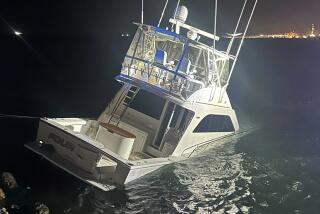‘Boat People’ Now Safer : Thailand Cracks Down on Pirates Raiding Refugees
SONGKHLA, Thailand — Lt. Col. Prakob Benjapong stood before his rogues’ gallery of Thai fishermen accused of attacking Vietnamese refugee boats on the high seas.
“These men,” he declared, waving a pointer at the color photos, “have committed crimes. They have violated human rights. They have created a bad image for our country.”
That image is one of wanton piracy, of murder and rape. But in the past year, Prakob’s men, members of the Marine Police, have begun to erase the stain.
In 1986, 50 Thais were arrested on piracy charges, more than the combined total of the previous four years. The arrests coincided with a sharp drop in the percentage of pirate attacks on refugee boats reaching Thailand.
Thai authorities, refugee officials and foreign diplomats give the Marine Police much of the credit.
“Good police work, good arrests,” an American diplomat monitoring Thailand’s anti-piracy program commented.
The program was established in 1982, funded by the Office of U.N. High Commissioner for Refugees (UNHCR). The United States is one of 11 international contributors, putting up 40% of the program’s $2.52-million annual budget.
The money goes for both operations and equipment, including navy and police patrol boats. But, said Prakob, who is deputy commander of the Marine Police headquarters here, “the sea is so wide it’s unusual for patrol craft to come upon an act of piracy.”
So the arrests by his men are the result of old-school detective work.
“When a refugee boat reaches shore,” he explained, “the UNHCR representatives do the initial interviews. We (the Marine Police) are not allowed on a beached boat. If the refugees say they were attacked, they are asked to identify the pirate boat, by registration number, by color, whether it was rigged for radar--that sort of thing.”
There are about 4,000 fishing trawlers in Songkhla harbor alone, so finding a suspect boat takes time and shoe leather. “Sometimes the fishermen repaint the boat, or alter the registration number,” Prakob noted.
Even with a good case and a tip from one informer, he said, prosecution depends on identification of the suspects by a refugee. A stranger in a foreign country, without proper papers, the accuser can lose the necessary nerve. Some, worried that a court case might delay their chance for resettlement, refuse to cooperate. With a good case and a willing refugee, however, police find the courts in southern Thailand unhesitating.
Most Are Convicted
“Most cases end in conviction,” said Franklin Huddle, the American consul in Songkhla, “and the sentences are far more than a slap on the hand.” According to U.N. figures, 80 Thais have been arrested under the program, including the 50 last year. So far, 36 have been sentenced, one to the gallows, and 23 have cases pending.
Piracy is not new to the Gulf of Thailand and other Southeast Asian waters. Fishermen from Vietnam, Cambodia, Thailand and Malaysia often work the same areas, and in the past it was not uncommon for a fishing boat to attack another for its catch.
The pirate attacks on refugees began in 1978-79, when relations between Vietnam and China soured and the Vietnamese government began to squeeze its ethnic Chinese communities. The Chinese and some ethnic Vietnamese took to the sea, and in 1979 more than 200,000 refugees reached shelter on other Southeast Asian shores.
Uncounted thousands never made it, the victims of storms, unseaworthy ships and pirates. Refugee piracy in the Gulf of Thailand became notorious. Kra Island off the southern Thai coast was a pirate stash for Vietnamese women. Chinese gold and other valuables turned fishermen into buccaneers.
Piracy Rate Dropping
The numbers have decreased in the years since. Last year, 19,575 Vietnamese refugees reached sanctuary somewhere in Asia, including 3,886 in Thailand. The percentage reporting pirate attacks also declined. In 1980, 80% of the refugee boats reported attacks; in 1985, the figure for those reaching Thailand was 24%, and last year 13%.
However, in 1986 the number of “boat people” exceeded, for the first time since 1983, the refugees leaving Vietnam under the U.N. High Commissioner’s Orderly Departure Program, a legal exodus established in 1979. The program was designed largely to stem the tide of “boat people.”
The boats reaching Thailand land in three general locations: the east coast, a short trip in coastal waters and less subject to piracy; oil rigs operated by Unocal in the Gulf, where the California-based oil company provides temporary humanitarian aid, and the southern coast, the farthest destination and therefore most dangerous, but still the most heavily traveled route.
“The odds of a pirate attack are 50-50 when headed for a southern port,” one refugee official estimated.
At the southern fishing port of Pattani early this month, two former South Vietnamese army officers knew that they had beaten the odds.
Group Was ‘Very Lucky’
“We were lucky, very lucky,” said Le Truc Lam, who said he built the boat that carried 22 refugees to Pattani two months ago. Since then, his group has lived in an open-sided thatch house on the Pattani beach, waiting for processing by refugee officials. A Christian clergyman has provided food and clothing. The UNHCR arranged for the house.
Speaking a bit of French and some English, Le said his boat was at sea for five days, a “miserable and dangerous trip.” He had heard of the piracy problem on Voice of America broadcasts, Le said, “but I had courage” and saw no pirates. “We saw a fishing boat, and the Thai fishermen pointed the way to the coast,” he said. “No problem.”
Le said he had been an infantry lieutenant in the South Vietnamese army, and served two years in a re-education camp when the Communists defeated the U.S.-backed southern government. He became an engineer in a Ho Chi Minh City ice plant on his release, and began planning his escape a year ago.
Another former officer, Trieu Duc Quyen, skippered their 27-foot craft, powered by a 22-hp engine and designed for river travel.
Le said refugees from three boats are encamped in the house on the beach: his group of 22, a second boat that carried just three men, and a third, which bore a lone woman.
Woman Recounts Attacks
As Le talked to a reporter, the woman stood listlessly against a post. Her nose was broken; her head lolled. Le at first declined to speak about her but later said she had been raped by pirates.
A week later, a letter arrived at The Times office in Bangkok from the woman, with her picture, detailing the ordeal. Her name, she wrote, was Thuy Nhu Nguyen Thi, and she was 23 years old. She said she had set out from Vietnam on Feb. 12 with her husband, two other women, a 6-year-old girl and three other men.
Eleven hours after leaving an unspecified point in Vietnam, the letter said, they were taken in tow by a Thai fishing boat and the girl and the three women were brought aboard. The three women she wrote “were raped very savage by the Thai sailors.” Before she reached the southern shore of Thailand nine days later, she said, she was passed to three other boats, and only on the last were the sailors “gentle.” She said she did not know what happened to her husband and the others with whom she set out from Vietnam.
The letter concluded “I always have believed in the correctness and humanity which will be the winners. Please to announce this crime on the press, and help us seek for seven familiar persons, among them is my husband.”
It was signed “One unhappy woman.”
20 Days Without Food
Horror tales continue in refugee circles. Survivors on a boat that arrived in Malaysia in January told of being at sea 20 days without food and turning to the flesh of a dead companion.
Twenty-four had set out for the Philippines, normally a three-day trip. They went off course, and eight of them died, four by drowning as they tried to swim to passing ships, and four others of starvation.
On Thailand’s southern coast, a 250-mile voyage over rough seas at this time of year, most arriving refugees are from the far south of Vietnam, around the Ca Mau Peninsula.
Boats from Ho Chi Minh City or the Mekong Delta head for Malaysia’s Bidong Island.
They usually come in groups of 15 to 25 here.
“We had a guy come in last year in a 10-foot rowboat,” said a refugee worker. “He was a bit tired.”
The trip takes about three days if there is no trouble. The refugee aide said that many refugees tell of receiving help from Thai fishermen along the way: directions, a tow, water or dried fish. Still, it is a dangerous run to Songkhla, he said, noting U.N. statistics that two-thirds of the refugees reaching Thailand last year landed on the southern coast, and 44% of those reported pirate attacks.
Try to Avoid Fishermen
If possible, most refugee skippers, though hardly experienced seamen, try to outrun or steer clear of any fishing boat. Others, short of supplies, approach the 60-foot trawlers and ask for help. Some receive it and others meet trouble instead.
According to police and refugee workers, piracy in the Gulf of Thailand is not a cutlass-waving boarding party. The refugees may ask for a tow for a disabled boat. The women and children are put aboard the trawler for safety at first, and then, after nightfall, the assaults begin, often gang rapes.
Survivors report that the fishermen sometimes argue about what to do with the refugees, wrestling with moral questions. Some may be affected by government attempts to shift public attitudes against piracy, using propaganda shadow plays and musical shows.
The fishermen may question whether it is worth the risk. The courts and the police are bearing down, and the refugees of today are not carrying the valuables that the Chinese brought out six or seven years ago.
“ ‘Is it worth it for a gold ring?’ they must ask themselves,” the refugee worker said.
The hesitation may be reflected in the declining percentage of attacks. In the first two months of this year, for instance, the attack rate for boats reaching the south was 23%.
Attacks Far From Shore
However, rapacious pirates are still at sea--fishermen who will ram the small refugee boats. or those who will offer a tow, take the women aboard, then pull the boat in circles until it is swamped and sinks.
Most of the attacks, police believe, take place far from shore, either to avoid navy and police patrols, or simply as a matter of first opportunity.
No reliable statistics exist on the refugee ships that never reach shore. Some boats have been attacked by the Vietnamese themselves, perhaps by the same men who took the bribes to let the boats clear port in the first place.
Many others are surely lost at sea. Most are river boats, 25- to 30-foot vessels of shallow draft, handled by inexperienced men. Some are scuttled by pirates after being looted. There are no survivors to report any of these incidents.
The flow of Vietnamese “boat people” reaching sanctuary has continued at about 20,000 annually over the past few years, dipping slightly each 12 months. If the U.N. Orderly Departure Program runs into trouble--a diplomatic possibility--the seaborne flight may swell again, despite the risks.
For now, though, the Thai authorities and the U.N. operation appear to have begun to curb the threat of piracy by increasing the risk to the pirates.
More to Read
Sign up for Essential California
The most important California stories and recommendations in your inbox every morning.
You may occasionally receive promotional content from the Los Angeles Times.










